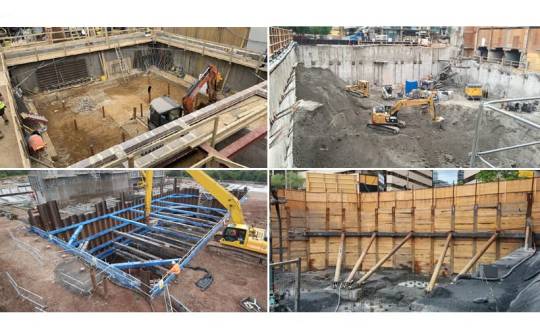Don't wanna be here? Send us removal request.
Text
How Smart Technology Is Transforming Basement Excavation Projects

Sustainable Basement Excavation Methods in 2025
As environmental concerns grow and construction practices evolve, sustainability has become a key focus in basement excavation projects. In 2025, homeowners, developers, and contractors are increasingly turning to eco-friendly methods to minimize environmental impact, reduce waste, and conserve energy all while maintaining the quality and durability of the build.
This blog explores the most effective and widely adopted sustainable basement excavation methods in 2025, along with their benefits and future potential.
1. Low-Impact Excavation Techniques
Conventional excavation practices typically rely on fuel-intensive machinery, leading to significant carbon emissions and environmental strain. In 2025, low-impact excavation equipment powered by electricity or hybrid engines is reducing the carbon footprint on-site. These machines operate more quietly, use less energy, and cause minimal disruption to the surrounding soil and structures.
2. Soil Reuse and On-Site Recycling
Instead of hauling away excavated soil, many projects now adopt on-site soil reuse practices. After testing and treatment, suitable soil is repurposed for landscaping, backfilling, or grading. Similarly, concrete and rubble from demolished structures are crushed and reused as base material, drastically cutting down landfill waste.
3. Green Material Selection for Retaining Walls and Foundations
Eco-conscious contractors are choosing recycled concrete blocks, sustainable steel, and low-carbon cement for retaining walls and foundational work. These materials offer the same strength and durability but significantly lower the embodied energy in construction.
4. Water Management and Rainwater Harvesting Systems
Digging and soil disturbance during excavation can alter natural drainage patterns, often causing runoff and increased soil erosion. In 2025, sustainable drainage systems (SuDS) and rainwater harvesting setups are integrated into basement designs. These systems capture, filter, and reuse rainwater for gardening, flushing, or cooling, making efficient use of natural resources.
5. Smart Planning with Digital Tools
Building Information Modelling (BIM) and Geographic Information Systems (GIS) help plan basement excavations with precision, reducing waste and avoiding unnecessary digging. These digital tools ensure every cut is calculated, avoiding over-excavation and conserving energy and materials throughout the process.
6. Use of Geotextiles and Natural Barriers
Instead of using chemical barriers for soil stability and water control, many sites now use biodegradable geotextiles and natural clay linings. These solutions stabilize soil, prevent erosion, and are safe for the environment.
7. Noise and Dust Control Measures
Eco-friendly excavation in 2025 means keeping noise and air pollution to a minimum. Projects now use dust suppression systems, soundproof barriers, and low-noise machinery, creating cleaner and safer conditions for both workers and nearby residents.
8. Energy-Efficient Site Lighting and Power
Temporary site infrastructure is becoming greener too. Solar-powered lighting, LED setups, and battery storage systems now replace diesel generators, further reducing emissions during excavation and construction.
Conclusion
Sustainable basement excavation in 2025 is not just about reducing environmental harm. it's about building smarter, cleaner, and more responsibly. By using modern technologies, recycling resources, and planning thoughtfully, contractors and homeowners can ensure their basement projects are both future-ready and environmentally sound.
The future of excavation lies not only in going deeper but also in building better for the planet..
0 notes
Text
How to Build a Fully Insulated Stunning Garden Room
In today’s busy city lifestyle, homeowners are increasingly looking for smart ways to expand their living spaces. While Basement Conversion in London continues to be a trusted method for creating extra room below ground, fully insulated garden rooms have emerged as a stylish and practical alternative for gaining more functional space outdoors.
Here’s how you can plan and build a garden room that is both stunning in design and comfortable all year round.

1. Plan the Purpose and Design
Begin by deciding how you want to use your garden room. Will it be a peaceful home office, a fitness studio, a guest room, or a creative workspace? Your intended use will determine the layout, size, and required features. Choose a design that suits both your personal taste and the overall look of your home and garden.
If you are already investing in a Basement Conversion in London, consider using similar materials and finishes to maintain a unified property style.
2. Select the Ideal Location
Your garden room should be placed where it receives enough natural light, has easy access, and offers some privacy. Most garden rooms fall under permitted development rights, but always confirm with local planning authorities, especially if you live in a conservation area.
3. Lay a Strong Foundation
A solid and insulated base is key to durability and energy efficiency. Common foundation options include concrete slabs and ground screws. Incorporate damp-proof membranes and rigid insulation beneath the floor to avoid cold spots and moisture buildup.
4. Use High-Quality Insulated Panels
Insulated wall panels are essential for year-round comfort. Choose Structural Insulated Panels (SIPs) or timber frame walls filled with insulation to retain warmth in winter and keep the space cool in summer. Add proper insulation in the roof and floor to complete the thermal envelope.
5. Install Energy-Efficient Doors and Windows
To maximize natural light while maintaining insulation, install double or triple-glazed windows and doors. Folding and sliding glass doors are a top choice for garden rooms, creating an open, airy feel while connecting the indoor space directly to your garden
6. Heating and Ventilation
For heating, electric radiators, underfloor systems, or infrared panels are efficient choices. Good airflow is also crucial, so include windows that open or mechanical ventilation systems to keep the air fresh and dry.
7. Interior and Exterior Finishing
Inside, you can choose from plasterboard, wood cladding, or modern panels for a clean and stylish look. Outside, finishes like timber, composite panels, or painted render can help your garden room blend beautifully with the surroundings. Add lighting, flooring, and furniture that reflect the room’s purpose and your personal style.
8. Plan for the Future
Think long-term and install electrical sockets, data points, and even plumbing if needed. This makes it easier to upgrade the space later into something more versatile like a guest suite or hobby room.
Basement Conversion in London or Garden Room
A Basement Conversion in London offers substantial living space below your existing home and is ideal for long-term use, especially where outdoor space is limited. A garden room, on the other hand, offers a quicker and less disruptive way to create a self-contained area surrounded by greenery. Many homeowners in London choose to invest in both, creating flexible zones for work, leisure, and family life.
0 notes
Text

Basement Construction London: Building Smart Below Ground
With space becoming harder to find in London, more homeowners and developers are starting to see the basement as a valuable area worth transforming. Whether you’re looking to increase your living space, add property value, or create a rental opportunity, basement construction in London offers a smart, long-term solution tailored to urban living.
Why Basement Construction Is Gaining Popularity in London
In a city where extending outward is often restricted and moving house comes with high costs, digging down is becoming the practical choice. Basement construction helps you make the most of the space you already have, without sacrificing your garden, changing the exterior of your home, or moving out of your neighbourhood. For many Londoners, it’s the perfect way to adapt their homes to modern needs.
Types of Basement Construction
1. New Build Basements
These are included in the original design of newly constructed homes or buildings. Planning and construction go hand in hand from day one, making it easier to incorporate natural light, drainage, and structural support.
2. Retrofit or Existing Basement Conversion
Common in older London homes, this involves converting a current cellar into a liveable space. It may require structural strengthening, underpinning, waterproofing, and modern finishes to bring it up to habitable standards.
3. Basement Excavation
When there’s no existing basement, but the property allows for it, excavation is done beneath the home. This process requires careful planning, skilled engineering, and close attention to neighbouring properties, particularly in the more crowded parts of London.
Key Steps in Basement Construction
Site Survey and Feasibility
Before any work begins, a detailed site survey is conducted to assess soil type, drainage conditions, and structural viability. In London, older buildings or those in tight rows may need special planning.
Planning Permission and Building Regulations
Some basement projects fall under permitted development rights, but many will require planning permission, especially if structural changes or light wells are involved. London boroughs have specific rules that must be followed, and building regulations approval is always necessary.
Excavation and Underpinning
Excavation is carefully carried out to avoid disturbing the main structure or neighboring foundations. Underpinning ensures the existing building remains stable during and after construction.
Waterproofing and Drainage
London’s unpredictable weather and underground water levels demand robust waterproofing systems, such as cavity drain membranes or tanking. Proper drainage channels are also installed to manage water safely.
Fit-Out and Design
Once the shell is complete, the space is fitted with plumbing, electricals, insulation, and finishes. Whether it becomes a home cinema, office, bedroom suite, or gym, the design is tailored to your lifestyle.
Challenges to Be Aware Of
Party Wall Agreements may be required if your property adjoins another.
Access limitations can slow construction in tightly packed neighborhoods.
Noise and disruption during excavation is inevitable but can be managed with proper planning.
Working with experienced London-based basement contractors ensures these challenges are handled smoothly and in compliance with local laws.
What Can You Use a Basement For?
Home office or study
Extra bedroom or guest suite
Luxury bathroom or spa area
Games or cinema room
Rental unit or nanny quarters
Storage with style (wine cellar, utility room, etc.)
Your basement can be tailored to suit your lifestyle, whether it’s for everyday use or future plans.
Basement Construction Costs in London
Prices vary depending on the size of the basement, depth of excavation, soil type, finishes, and access. On average, basement construction in London ranges from £3,000 to £5,000 per square metre, with high-end designs costing more.
While the investment may seem significant, the added property value and functional space often deliver a strong return, especially in London’s competitive property market.
Conclusion
Basement construction in London is more than just a passing trend. It’s a practical and forward-thinking solution to the space challenges of one of the world’s busiest cities. Whether you’re enhancing your family home or increasing property value, a professionally built basement offers the flexibility, comfort, and functionality that modern London living demands.
Choose the right specialists, understand the regulations, and you’ll unlock the true potential beneath your feet.
1 note
·
View note